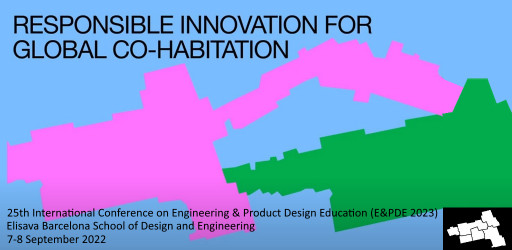Type:
Year:
2023
Editor:
Buck, Lyndon; Grierson, Hilary; Bohemia, Erik
Author:
Series:
E&PDE
Institution:
Glasgow School of Art, United Kingdom
Section:
Responsible innovation in design and engineering education
DOI number:
ISBN:
978-1-912254-19-4
Abstract:
Designing for a circular economy introduces complex networks, collaborations, and relationships into the context of product design. Increasingly, the context within which young undergraduate and postgraduate students of product design and engineering are designing within is represented not only by the customer or the user of their products, but also includes a wide range of stakeholders, services, and systems. As the design process expands from technocentric and user-centric to include and reference the wider context of designing for people and communities within complex product, service, system, and environmental relationships of a circular economy, it becomes increasingly challenging for product design and engineering students to cope with and design within a more holistic and complex product-service-ecosystem. How do you avoid designing in the abstraction of system diagrams and stakeholder maps to design for people, communities and the planet? In 2000-2001, founders of LiveWork and Engine service design consultancies, being product designers before specialising in service design, have long recognised the need to see the people engaged with services and understand the ‘highly complicated networks of relationships between people inside and outside the service organisation’ (Polaine et al, 2013, p.36). Borrowing from systems and actor network theories, service designers developed journey-maps, relationship maps and service blueprints to bring service ecosystems to life, capturing and communicating insights from research and observations, visualising people and their relationships within the service ecology. Product designers have since borrowed from service design methods helping them to more deeply understand and empathise with people they are designing for and with (Bailey, 2012). This paper discusses the integration of service design methods within a product design process that enables students to: identify and communicate design opportunities from design ethnographic research: explore design opportunities as value propositions: identify and share the core values and proposed benefits of circular design opportunities: develop and present product-service concepts. This paper discusses the multidisciplinary nature of designing for the circular economy requiring product designers and engineers to investigate, understand and communicate a wide range of stakeholder relationships and interactions when developing their design propositions, building empathy and trust. Service design tools such as stakeholder mapping visualise actor networks and product-service ecosystems: their relationships, interactions and behaviours, bringing the systems and actors to life. Journey maps record observational research and can be used as analytical tools to build insights and visualise the key value propositions of the product-service design. Service-blueprints visualise how different product-service pathways interact across time. Integrating these methods and tools into the product design process helps the product design engineering students to ‘see’ and communicate key insights from their research to share and communicate the circular value propositions offered by the design.
Keywords:





